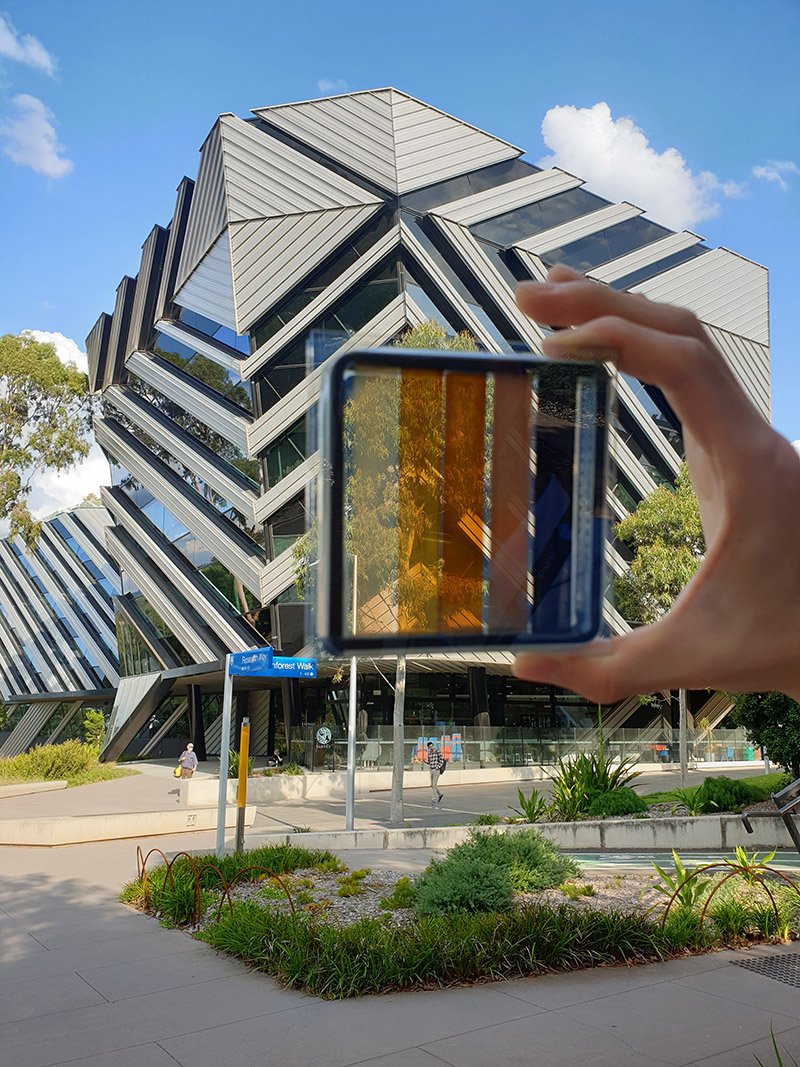

It’s a literal example of ‘blue sky thinking’ – you’re staring out the window of your home or office on a clear day, the world lit up by bright sunlight. And then the idea hits you – what if the glass protecting me from the elements could be made to work a bit harder?

Windows that generate their own electricity have been an ambitious goal for some time now, but thanks to the ARC Centre of Excellence in Exciton Science, progress from a dream to the drawing board and then the design workshop itself is beginning to accelerate.
In April 2020, as the world was coming to terms with the confronting reality of the COVID-19 pandemic, an exciting research development punctured the collective gloom.
The group led by Chief Investigator Jacek Jasieniak at Monash University, including Dr Jae choul Yu and with important contributions from CSIRO’s Dr Anthony Chesman and Dr Chris Dunn, published the paper “Semi-transparent perovskite solar cells with a cross-linked hole transport layer” in the journal Nano Energy.
While that title would have resonated with few people beyond a small number of specialists, the implications were considerable – work towards realising the ‘solar window’ dream had taken a big step forward.
By demonstrating that semi-transparent solar cells, made using next-generation perovskite materials, could be successfully incorporated into window glass with relatively high degrees of energy efficiency, the researchers compelled their peers, the media and the public to sit up and take notice.
“People are exposed to windows all the time, every day,” Jacek said.
“But it’s not every day they’re presented with the fact that actually, those windows could be doing something a bit more useful.”

A semi-transparent perovskite solar cell with contrasting levels of light transparency.
Credits: Dr Jae Choul Yu
We need them to know we are thinking about the right types of questions and they’re excited. So, at the dinner table their seven-year-old daughter can say, ‘I read about this’. That’s a marker of success. It’s about exciting people. What I care about is that the next generation of scientists or engineers are motivated and inspired.
It will take some time for other groups around the world to replicate the results and begin to publish research that builds on this development, but Jacek has already received recognition from his peers and expects the paper to become highly cited.
For journalists and general audiences, though, the response was immediate. As many as 75 stories were published about the paper around the world, ranging from specialist publications like Grand Designs Magazine and Architecture and Design to major international outlets Yahoo News and renewable energy specialists Renew Economy and PV Magazine.
Jacek was interviewed by Spain’s Agencia EFE, the fourth largest news wire service in the world, leading to widespread coverage of the story in Spain and Latin America.
The exciting concept also proved to be a big hit on Exciton Science’s digital and social media channels.
The story received over 1,120 unique page views on the Centre’s website. Social media posts about the research reached approximately 28,500 users, resulting in around 3,370 instances of engagement across Facebook, Instagram, Twitter and LinkedIn.
And that sort of recognition matters just as much to Jacek and his colleagues as academic acknowledgement.
“I think it’s really important that we get our stories out there and people know what we’re doing,” he said.
“We need them to know we are thinking about the right types of questions and they’re excited. So, at the dinner table their seven-year-old daughter can say, ‘I read about this’. That’s a marker of success. It’s about exciting people. What I care about is that the next generation of scientists or engineers are motivated and inspired.”
Now, Jacek’s team are preparing to tackle the challenge of progressing from their early proof of concept to developing prototypes that can be commercialised and implemented in real-world conditions.
According to Jacek, the next steps are “really understanding an ideal device structure for scaling to the level of a large window. What does that look like?
“The types of devices that we have demonstrated have all been relatively small, which is good for understanding the device physics. But as soon as you try and scale that, you have deposition challenges for the materials that are used. You’ve also got structural challenges from the actual device architecture and how it’s interfaced within the window to make a functional solar cell.”
Addressing these next challenges will require an inter-disciplinary approach, and strong involvement from the building sector to make such a technology “usable”.
As Exciton Science researchers and their collaborators get to work tackling those issues, we can start to dream a little more realistically of a time when windows don’t just keep the weather out, but can sustainably harness the power of the sun.